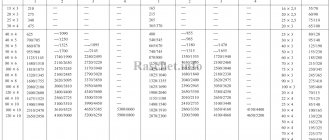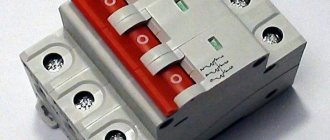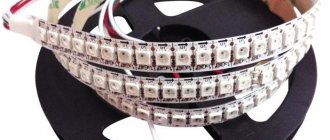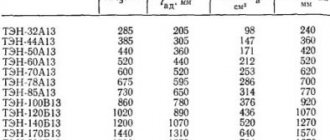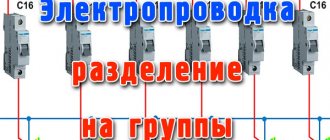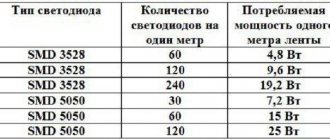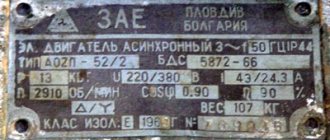Classification of circuit breakers
When choosing the right device for supplying voltage and disconnecting it, manually or automatically, you need to select them based on the class. Here are the household classes of automatic circuit breakers based on instantaneous tripping current:
- Type B: above 3*I nom. up to 5*I nom. inclusive (where I nom is the rated current). They are used to protect lighting lines or lines laid over long distances;
- Type C: over 5*I nom. up to 10*I nom. inclusive. These classes of circuit breakers are used to protect socket groups or circuits with consumers with average inrush currents.
- Type D: over 10*I nom. up to 20*I nom. inclusive. Used to protect transformers or consumer circuits with high inrush currents.
Industrial grades:
- type L: over 8*I nom.
- type Z: over 4*I nom.
- type K: over 12*I nom.
The classification of Western manufacturers is slightly different.
Deciding on the denomination
Actually, from the functions of the circuit breaker, the rule for determining the rating of the circuit breaker follows: it must operate until the current exceeds the capabilities of the wiring. This means that the current rating of the machine must be less than the maximum current that the wiring can withstand.
For each line you need to choose the right circuit breaker
Based on this, the algorithm for selecting a circuit breaker is simple:
- Calculate the wiring cross-section for a specific area.
- See what maximum current this cable can withstand (see the table).
- Next, from all the ratings of the circuit breakers, we select the nearest smaller one. The ratings of the machines are tied to the permissible long-term load currents for a particular cable - they have a slightly lower rating (see the table). The list of denominations looks like this: 16 A, 25 A, 32 A, 40 A, 63 A. From this list you choose the appropriate one. There are smaller values, but they are practically not used anymore - we have too many electrical appliances and they have considerable power.
The algorithm is very simple, but it works flawlessly. To make it clearer, let's look at an example. Below is a table that shows the maximum permissible current for conductors that are used when laying wiring in a house and apartment. Recommendations regarding the use of machines are also given there. They are given in the column “Nominal current of the circuit breaker”. This is where we look for the ratings - it is slightly less than the maximum permissible for the wiring to work normally.
Cross section of copper wires
Permissible continuous load current
Maximum load power for single-phase network 220 V
Rated current of circuit breaker
In the table we find the selected wire cross-section for this line. Suppose we need to lay a cable with a cross-section of 2.5 mm 2 (the most common when laying to medium-power devices). A conductor with this cross-section can withstand a current of 27 A, and the recommended rating of the machine is 16 A.
How will the circuit work then? As long as the current does not exceed 25 A, the machine does not turn off, everything works as normal - the conductor heats up, but not to critical values. When the load current begins to increase and exceeds 25 A, the machine does not turn off for some time - perhaps these are starting currents and they are short-lived. It turns off if the current exceeds 25 A by 13% for a sufficiently long time. In this case, if it reaches 28.25 A. Then the power supply will work and de-energize the branch, since this current already poses a threat to the conductor and its insulation.
Power calculation
Is it possible to choose a machine based on load power? If only one device is connected to the power line (usually large household appliances with high power consumption), then it is permissible to make a calculation based on the power of this equipment. You can also choose an introductory machine based on power, which is installed at the entrance to a house or apartment.
If we are looking for the rating of the input circuit breaker, we need to add up the power of all devices that will be connected to the home network. Then the found total power is substituted into the formula, and the operating current for this load is found.
Formula for calculating current from total power
After we have found the current, select the nominal value. It may be either slightly more or slightly less than the found value. The main thing is that its shutdown current does not exceed the maximum permissible current for this wiring.
When can you use this method? If the wiring is laid with a large margin (this is not bad, by the way). Then, in order to save money, you can automatically install switches corresponding to the load, and not the cross-section of the conductors
But once again we draw your attention to the fact that the long-term permissible current for the load must be greater than the maximum current of the circuit breaker. Only then will the choice of circuit breaker be correct
Connecting a two-pole circuit breaker
Before connecting the circuit breaker, you need to understand the purpose of this device, its functions and capabilities. An automatic two-pole switch is, by and large, two single-pole circuit breakers assembled in a single housing. According to the PUE, it is impossible to disconnect only one phase wire or a neutral wire in order to ensure the safe operation of electrical installations. This device has several protections:
- From a short circuit, that is, from a sharp increase in large currents that arise in the circuit;
- From a long-term increase in current above the rated current, by a given and clearly advertised amount.
That is, the machine will turn off emergencyly if, for example, it is designed for a working current equal to 20 A, and for 20 minutes, for example, 25 A will flow through it; a thermal relay will operate in it, which may prevent it from being turned on again. Only after the circuit breaker, or rather its thermal relay, has cooled down to operating temperature will it be possible to turn it on again. The machine will also turn off if a short circuit occurs in the outgoing circuit, that is, the one that went to consumers.
To connect the switch, you first need to decide on the energy source, that is, where it will be powered from. The installation of automatic switches in the panel will be carried out in any case, also from a machine only with a higher rating.
The source to which you can connect the upper contacts of the machine is known; now you need to decide whether it will withstand all the loads and all the consumers that will be connected. Each electrical device has its own ratings:
- Power consumption;
- Voltage;
- Current strength.
Read more: LED lamps ASD purpose, types of light bulbs and opinion about the product
Each is important, but sometimes some appliances may only list wattage and voltage. You can determine the approximate current strength yourself; to do this, the power of the electrical appliance must be divided by its operating voltage. The power supply should be selected according to the sum of all devices that will be connected to it.
For example, if there are three electrical devices that will consume 5 A each during their operation, then the circuit breaker should have a little margin of 20–25 A. Then the flowing operating current will be equal to 15 Amperes, with the operating current of the machine being 25. All devices will operate normally, without overheating.
And in emergency situations, the entire circuit will be immediately turned off, thereby ensuring reliable fire safety of the room. Polarity in AC voltage circuits does not matter, so it makes no difference which terminals the phase will be connected to and which the zero will be connected to. In DC circuits, double-pole switches are also often used. One of the terminals is negative, the other is positive, but in everyday life constant voltage is used very rarely.
Selection mistakes to consider
Finally, let's look at the most common mistakes that are made when choosing a circuit breaker.
Error 1.
When choosing an automatic machine, they are guided by the total power of consumers, which is one of the most serious mistakes.
The machine only protects the wiring from overloads; it is unable to change its characteristics.
If you place a powerful machine on weak wiring and connect a strong energy consumer to it, this will inevitably lead to damage to the wiring, and the machine will not be able to do its job.
Therefore, you should always focus on the cross-section of the wire and its throughput, and not on the power of the consumers.
Error 2.
Often, all branches of the network are equipped with the same machines, and then they try to use one of the branches as a heavily loaded one.
Even at the stage of installation of the electrical network, it is advisable to ensure that at least one of the branches has increased parameters and is equipped with a circuit breaker designed for significant loads.
For example, in the garage of a private house, it is possible to use devices that create a significant load.
It is better to strengthen this branch in advance than to redo it later or hope that the machine or wiring will “stand.”
Error 3.
When purchasing circuit breakers, buyers try to minimize costs. It's better not to skimp on safety.
You should buy such devices only from well-established companies in specialized stores, and even better from an official distributor.
We hope that the tips above will help you choose the right circuit breaker for your home.
Double-pole switch: capabilities and purpose
The main characteristic of all machines is the speed of shutdown in emergency situations and the shutdown ability. All circuit breakers can be triggered by 2 types of tripping mechanisms, namely: thermal and electromagnetic. The electromagnetic mechanism opens the voltage circuit when a short circuit occurs, and the thermal mechanism turns off if there is a continuous load in the network that exceeds the permissible limit.
Installing a machine that has 2 poles makes it possible to control some parameters.
Namely:
- With such an automatic machine, it is possible to control 2 electrical wiring circuits independent from each other, with their simultaneous shutdown in the event of a breakdown of any circuit;
- You can also control the parameters of each of the circuits, but if one of the circuits fails, the voltage supply to the second circuit is also turned off;
- Control of DC lines that have similar tripping.
Based on such characteristics, it is better to install a minimum two-pole circuit breaker in your home, since in the event of a breakdown, such a circuit breaker will de-energize not only a specific circuit, but also all electrical circuits in the house. With such a machine, you can turn it off manually if you need it.
This is interesting: How to seal an input switch - 4 ways
Time-current characteristic
What does this physical indicator mean? In principle, everything is quite simple. When the network is overloaded, especially when the load depends on the starting torque of the household appliance, the machine turns off. But since this load is short-term, sometimes there is no need to turn off the power supply. It turns out that the machine allows the device to turn on, and at the same time it does not cut off the supply of electricity to the electrical wiring of the building.
But there is one caveat. How long does it take for a household appliance to enter normal operating mode, and how quickly does it turn on? That is, how long will the inrush current last? It is the time indicator that is included in this characteristic of the circuit breaker. This creates conditions under which the shutdown of the machine will be reduced.
There are several machines with different time-current loads.
- Type-A. This device is used in linear networks in which the length of the electrical wiring is very long, or where semiconductor devices are installed. Withstands overload 2-3 times.
- Type-B. Usually installed in a network with an active load and a low multiplicity of the starting current torque. Typically, such machines are used in areas where lighting, stoves, heaters, and so on are installed. Overload is 3-5 rated loads.
- Type-S. Mounted in networks with moderate current loads. These are usually socket groups where air conditioners and refrigerators are connected. Withstands exceeding the nominal value by 5-10 times.
- Type-D. Used in circuits where units with high starting current are installed. These can be compressors, pumps, small machines. The excess is 10-20 denominations.
- Type-K. used in electrical circuits with inductive loads. Excess: 8-12.
- Type-Z. Such machines are installed in circuits into which electronic devices are connected. They are sensitive to overcurrents.
If we talk about domestic use, then most often types “B” and “C” are installed in electrical wiring, rarely “D”.
So, how to determine both characteristics on the circuit breaker itself? Usually on the case you can find the following designation: “C16” or any other, the main thing is that it is a letter of the Latin alphabet and a number. This indicates (in this case) that the current rating of the circuit breaker is 16 amperes, and the time-current characteristic classifies this device as type “C”. That is, this machine will withstand a current of 80-160 amperes for some time. Typically, the response time of the machine is 0.1 seconds.
How to calculate the rated current of a circuit breaker? Everything is quite simple. Let's look at this calculation using the example of a socket group where an electric kettle with a power of 1.5 kW, a refrigerator with a power of 400 W and a dishwasher with a power of 2.5 kW are connected.
First of all, it is necessary to determine the total power of consumers, which is equal to 4.4 kW. Now we insert all the indicators into the formula of Ohm’s law:
I=P/U=4400. 220=20 A. We have a machine with such a current load in our catalog, but it is necessary to take into account the conditions that were specified in the article above. That is, it is better to choose a circuit breaker with a higher current rating. And this will be 25 amperes.
Circuit breakers - technical characteristics and the right choice according to them
Characteristics of electric machines
Characteristics
The main parameters of the AB are usually marked on its frontal surface. These include:
- name of the manufacturing company;
- model;
- time-current characteristic (B, C, D, K, Z);
- rated current (In), A;
- rated voltage (Un), V;
- maximum shutdown current (Iotk), A.
Rice. 8. Basic parameters of the circuit breaker
The time-current characteristic determines the magnitude of the instantaneous shutdown current. In most household cases, class C ABs are used, for which this current is 5–10 values from In.
The most important parameter is In. This is the maximum current at which the AV does not yet operate. The values of In are standardized and equal to: 6, 10, 16, 20, 25, 32, 40, 50, 63, 80, 100 A.
Iotk is the maximum current permissible for the AV that occurs during a short circuit.
Video - Marking of circuit breakers. What do the labels on circuit breakers mean?
Types of Circuit Breakers
They are all divided into:
- low voltage - up to 1000 V;
- high voltage, above 1000 V.
It is immediately worth protecting from ill-considered use; in no case should low-voltage circuit breakers be used in high-voltage circuits. This is a separate type of this equipment, which requires not only correct installation, but also appropriate operation.
Another difference is related to their execution; it happens:
- Modular;
- Cast;
- Air power.
Modular switches are the most common types of switches used in apartments, houses, summer cottages, that is, in all everyday situations. They are very compact and conveniently mounted on a special strip called a DIN rail. You just need to release the fastening elements, which are tightened by a spring, and install the circuit breaker in the right place, most often this is an electrical panel. What size to install it depends on the amount of equipment in it. It must be locked securely with a key so that neither children nor anyone else can turn on the machine when work is being done on the line.
Installation of circuit breakers
The connection of circuit breakers in the distribution cabinet is carried out in a certain sequence. A cable connected to an external current source is inserted from above, and through the output holes located below, the wiring is routed to its objects, in accordance with the electrical diagram.
At the beginning of installation, the input circuit breaker is connected. If there are several lines in the circuit, isolated from each other, they are separated from the input circuit breaker. Its power must be no less than the total power of the machines connected to separate lines. For this purpose, two- or four-pole devices of group D are selected, resistant to the inclusion of power tools and other powerful equipment.
The most widespread are those suitable for any power supply schemes for apartments and private houses. Modular circuit breakers are installed on a DIN rail and connected by conductors with a current carrying capacity exceeding the operating current of the switch. A more convenient connection of several machines in one row can be done using a special connecting bus. A piece of the required length is cut from it and secured in the terminals. This connection is possible due to the distance between the bus contacts corresponding to the standard width of modular machines. The switch is installed per phase, and the neutral conductor is supplied from the input device directly to the devices.
- A single-pole
switch is used when installing sockets and lighting systems. - A two-pole
circuit breaker is suitable for high-power appliances, such as an electric stove or boiler. In case of overload, it is guaranteed to break the circuit. The connection diagram of such switches is practically no different from single-pole models. For more efficient use, it is recommended to connect them to a separate line. - A three-pole
circuit breaker should be installed only in cases where it is planned to use electrical appliances operating at a voltage of 380 V. In order to eliminate the load, the load is connected in a “triangle” pattern. This connection does not require a neutral conductor, and the consumer is connected to its own switch. - A four-pole
circuit breaker is most often used as an input circuit breaker. The main condition for connection is the uniform distribution of the load on all phases. When connecting equipment in a star configuration or three separate single-phase wires, excess current will flow through the neutral conductor.
With all loads evenly distributed, the neutral wire begins to perform a protective function in the event of unexpected power imbalances. To ensure a normal connection, only high-quality materials should be used. All connections must be securely fastened to the terminals. If several cables are connected at once, their contacts must be thoroughly cleaned and tinned.
The procedure for connection can be considered using the example of a two-pole circuit breaker installed in the panel. First of all, the power is turned off to completely de-energize the network. The absence of electricity is checked using an indicator screwdriver or a multimeter. Then the machine must be installed on the DIN rail and snapped into place. The absence of a mounting rail can create certain inconveniences. After this, the cores of the incoming and outgoing wires are stripped to a distance of 8-10 mm.
Input wires are connected to two clamps located on top -. The lower clamps hold similar outgoing conductors distributed to sockets, switches and electrical appliances. All wires are properly clamped into terminals using screws. Connections must be checked manually. To do this, the conductors need to be gently moved from side to side. If the connection is poor, the core will wobble in the terminal and may even jump out of it. In this case, the terminal screw needs to be tightened.
Upon completion of installation, voltage is supplied to the network and the functionality of the circuit breaker is checked.
How to choose a two-terminal network
Before installing a two-pole input circuit breaker, you must select its rated current corresponding to the power of the connected equipment. Our table will help simplify the calculations, with the help of which you can easily find the required values in order to connect a two-pole IEC circuit breaker, TN-C, etc.:
There is another simpler way to calculate the total power of a household network. For wiring in an apartment, this is easy to do. For example:
- 0.3 kW – refrigerator;
- 6 kW – electric stove and oven;
- 1.5 kW – other electrical appliances.
This turns out to be 7.8 kW. When choosing switches, you need to start from the nearest larger value. Suppose we have a two-phase electrical network, which means we settle on the indicator 45.6 according to the table. To protect the electrical system in your home, you will need a two-pole 40 Ampere circuit breaker.
Photo – legrand 63 ampere
Always pay attention to the designation on the machine; the rated operating current is indicated there. Check the quality certificate for compliance with operating parameters (thermal radiation, current, voltage)
What is the danger of a cable mismatch with the network load?
Selecting the correct power circuit breaker is a very important task. An incorrectly selected device will not protect the line from a sudden increase in current.
But it is equally important to choose the correct cross-section of the electrical cable. Otherwise, if the total power exceeds the rated value that the conductor can withstand, this will lead to a significant increase in the temperature of the latter
As a result, the insulating layer will begin to melt, which can lead to a fire.
To more clearly imagine the consequences of a mismatch between the wiring cross-section and the total power of the devices connected to the network, let’s consider this example.
New owners, having bought an apartment in an old house, install several modern household appliances in it, giving a total load on the circuit equal to 5 kW. The current equivalent in this case will be about 23 A. In accordance with this, a 25 A circuit breaker is included in the circuit. It would seem that the choice of the circuit breaker in terms of power was made correctly, and the network is ready for operation. But some time after turning on the appliances, smoke appears in the house with a characteristic smell of burnt insulation, and after a while a flame appears. The circuit breaker will not disconnect the network from the power supply - after all, the current rating does not exceed the permissible one.
If the owner is not nearby at this moment, the melted insulation will cause a short circuit after some time, which will finally trigger the machine, but the flames from the wiring may already spread throughout the house.
So that you do not have to take out a calculator and independently calculate the cross-section of electrical wiring using formulas, we present a standard table in which it is easy to find the desired value.
Selection by time-current characteristic
You can more accurately select an input circuit breaker for a private house if you take into account its time-current characteristics. In this case, do not forget about the rated current of the device. The selection method based on the time-current characteristic is especially relevant if equipment is connected to the electrical network, the operation of which requires significant inrush currents.
When electrical appliances in a building create standard loads on the electrical network, you can often find an installed circuit breaker with a rating of 16 A. Moreover, it belongs to the “C” variety. Devices with this characteristic are very often used in everyday life. Despite this, there are other time-current characteristics - A, B, D and so on.
The Latin letter is located on the case immediately after the amperage number of a particular machine. It denotes the type of time-current characteristic curve. The device of type A has the highest sensitivity. For switching devices with other letters, this characteristic decreases.
Common buying mistakes
When choosing equipment, people inexperienced in this area often make the same mistakes regarding load and current. If the protective device is chosen incorrectly, the consequences can be very costly and time-consuming.
To prevent such things from happening, you need to become familiar with common mistakes. In the future, this will allow you to choose the right circuit breaker for your apartment.
- When choosing the rating of the machine, you should pay more attention not to the power of all household appliances, lighting and electrical appliances, but to the condition of the electrical wiring. If the wiring is old, relying on the technical specifications of the electrical consumers used can be dangerous. For example, to protect an electric stove, a circuit breaker rating of 32 A is required, and the cross-sectional area of an old cable made of aluminum can only withstand a current of 10 A. The result is that the wiring overheats and melts, which causes a short circuit. If you need a powerful protective switch to meet all your needs, first of all you need to replace the wiring in your apartment.
- Electricians strongly recommend purchasing all the automation for your apartment from one manufacturer. This approach allows you to avoid problems associated with mismatch of elements during installation and operation of devices.
- You need to purchase circuit breakers only in specialized stores from an official representative of a well-known and well-established manufacturer. Only this approach will protect against the acquisition of counterfeits. When purchasing from official representatives, the cost of machines will be lower than from intermediaries.
It happens that when calculating the potential of a machine based on the operating current, the indicator comes out to be average between the existing ones. For example, the result is 14 A, and stores offer models with ratings of 10 A and 16 A. If new wiring is installed, you can give preference to the latest model. If there is no guarantee that the wiring will withstand such a load, it is better to choose the first one.
Device selection
To select a high-quality protective device, you need to focus on the conductor cross-section. To do this, you will need to calculate the power and current of the equipment and power line. Based on the displayed data, you can select a machine. As a rule, you can take all the information from special diagrams.
Criteria for choosing electrical equipment
A two-pole circuit breaker is a device designed to protect an electrical circuit. It has its own functional purpose, advantages and disadvantages. It also has its own technical characteristics.
You might be interested in: Installation of an electric meter
Description and principle of operation
Before discussing the principle of operation of the device, you need to find out why a two-pole differential circuit breaker is needed. If the voltage in the network increases or there is a short circuit, which can cause damage to some connected devices, the device turns off the power. In this case, both the phase wire and the neutral are disconnected.
Photo - two-pole circuit breaker
This implementation is provided for by the PUE (Rules for Installing Electrical Equipment), which states that it is prohibited to disconnect the phase wire without disconnecting the neutral. This electrical machine is installed in a panel (located in the vestibule or directly in the apartment) to power individual devices to control their operation. If necessary, you can turn off the electric current yourself.
Photo - two-terminal device in the shield
An automatic two-pole switch consists of two single-pole circuit breakers, which are connected by a lever and have a common internal locking mechanism. When high voltage or surges occur, both devices are switched off at once, which protects the wiring from fire. Therefore, it is strictly forbidden to use two separate single-pole devices instead of one double-pole device. Since in this case only one of them will turn off, while the second will continue to power the apartment or house.
Purpose of the machines:
To protect networks of residential buildings and businesses from fire hazards; control of the operation of individual high-power electrical devices (machines, electric stoves, generators, boilers, etc.) installed in the country house, garage, industrial premises, etc.; disconnecting the load during voltage surges; branching (structuring) of electrical wiring.
Basically, two-pole circuit breakers are used in apartments with two-pole wiring (phase and zero), which is standard for all houses built before 1990. For this purpose, a single-phase two-wire cable is used, which has a phase and neutral conductor.
Photo - machine for an apartment
Despite the fact that both of these wires are considered equivalent, and theoretically they can be swapped, when wiring, it is customary to choose the neutral wire in blue (or install a heat-shrinkable tube of the appropriate shade at its end).
Video: using a two-pole circuit breaker in everyday life
How to install the machine
The RCD must be installed on a DIN rail. The connection of a two-pole dif circuit breaker is carried out in front of the circuit breakers. You need to install the DIN rail onto the panel body using self-tapping screws, then, using a special latch on the switch, secure it to the rail. When the circuit breaker is securely fixed, you can begin connecting the device to the electrical network.
If several machines will be installed on one rail, then their standard dimensions (modularity) must be taken into account.
Very often, after an old RCD or plugs, burnt wires remain that need to be cut off for convenient connection of the switch. If necessary, the wire can be extended, but changing is not recommended. We remind you that you must strictly follow the connection diagram.
Photo - connecting a two-pole switch
If you have an RCD with adjustment installed, then before turning it on and setting it up, you should check the correct connection. Even experienced electricians sometimes make mistakes and swap the neutral and phase wires. Installation is also possible directly on the shield, but it is much more convenient to work with a DIN rail.
It is necessary to install a two-pole differential circuit breaker in compliance with the rules for installing electrical equipment and safety precautions:
In any circuits, electrical appliances must be installed by two electricians. In this case, one person carries out the installation, and the second ensures its safety; The connection diagram for a two-pole circuit breaker with independent input can be different, an example is provided in the drawing below;
Photo - example of connecting an ouzo
Replacement (installation of a new) RCD and other manipulations with electrical networks are carried out only after receiving special permission; To protect yourself from the danger of electric shock, you need to use special protective equipment (rubber gloves, dielectric mats, overhead protective grounding, etc.).
Connection diagram
It is proposed to consider the connection diagram of a two-pole circuit breaker.
Here VA 47-63 2/50A is an introductory two-pole circuit breaker. It completely de-energizes the entire circuit if necessary. A meter and an RCD are connected behind it. Next, a connection diagram for a number of single-pole circuit breakers is used. They are installed only on phase wires, and neutral wires are distributed via a bus.
There is a connection diagram for a number of two-pole circuit breakers, each protecting its own branch.
The RCD is connected first at the input, then two rows of two-pole switches. The neutral wire is blue, the phase wire is red, and the grounding distributed using a grounding bus is yellow. In this way, each branch of the circuit is protected.
What if you choose the wrong machine denomination?
The main mistakes that are made when you need to choose a machine based on load power are: choosing a rating that is too high or, conversely, a current rating that is too small.
If you choose a device with a low rating, the circuit breaker will constantly turn off when electrical appliances are operating, lighting will disappear and important mechanisms will stop working. In this case, the laid cable will have a power reserve, but the circuit breaker will not allow a current higher than its rating to pass through it (which will be less than the rating of the cable).
In the second case, if you choose the wrong machine, with a “reserve” of power, you will expose yourself to the risk of fire in the electrical wiring. Since the power for which the cable line is designed will be significantly lower than the capacity of the circuit breaker and it simply will not work, since the electric cable will already melt, and the circuit breaker will still have a reserve of work.
Plus, the higher the nominal value of the machine, the more expensive it is. If you make such a mistake, you will overpay and expose yourself to significant risk, the operation of the electrical system will be ineffective and unsafe.
Very often a problem arises that the machine turns off or does not work correctly, but its nominal value is selected correctly. This happens because the device class, which is associated with the characteristics of the release, is incorrectly selected.

